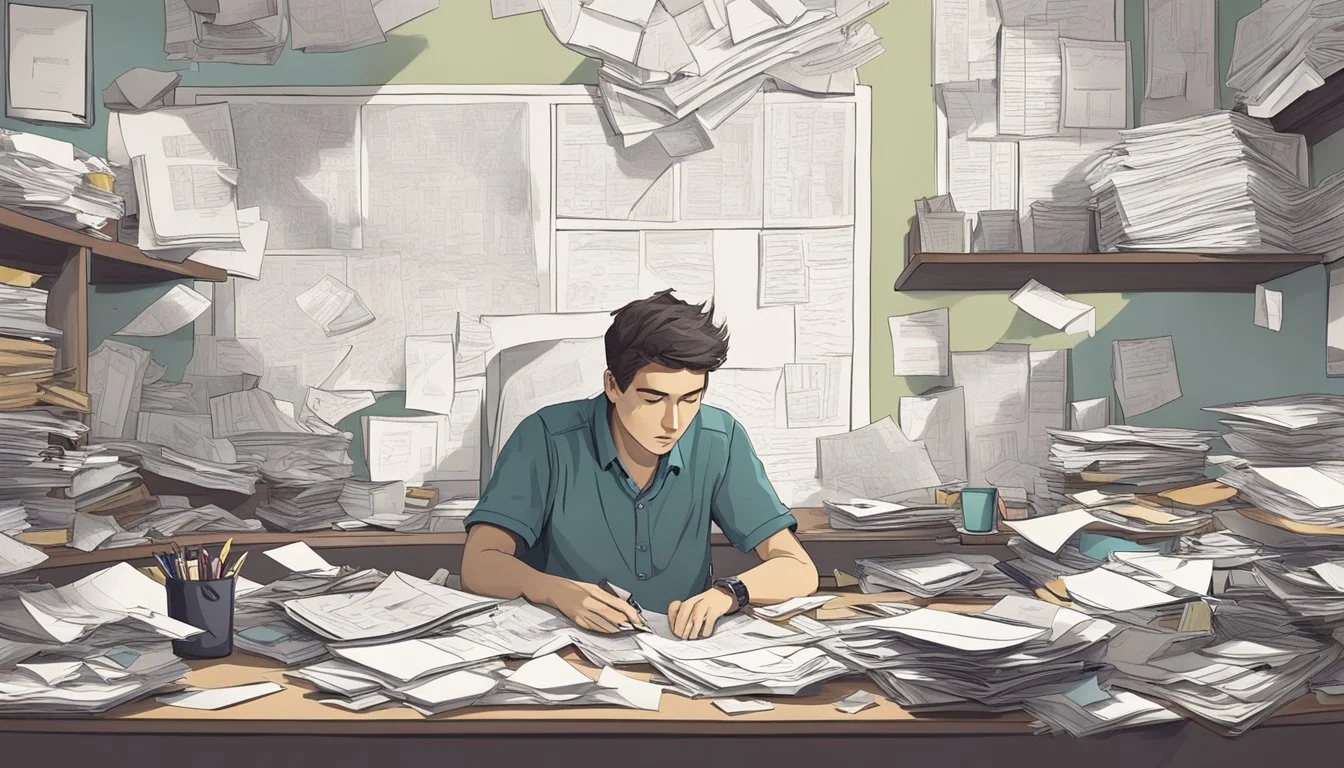Recognizing When Anxiety Evolves into Depression
Anxiety and depression are common mental health conditions that can significantly impact a person's daily life. While they are distinct disorders, anxiety and depression often overlap, with one potentially developing into the other over time. Recognizing the signs of this transition is crucial for early intervention and effective treatment.
Understanding the relationship between anxiety and depression can help individuals identify when their symptoms are evolving and seek appropriate support. Both conditions share some similar symptoms, such as changes in sleep patterns, difficulty concentrating, and feelings of restlessness. However, depression is characterized by persistent feelings of sadness and hopelessness, while anxiety typically involves excessive worry and fear about future events.
1) Persistent sadness or emptiness
Persistent sadness or emptiness is a hallmark sign that anxiety may be transitioning into depression. This feeling goes beyond occasional bouts of sadness and becomes a pervasive emotional state.
Individuals experiencing this symptom often describe a deep sense of hollowness or numbness that lingers throughout their days. They may find it difficult to feel joy or excitement, even in situations that previously brought them happiness.
This persistent low mood can impact various aspects of life, including work, relationships, and daily activities. People might struggle to engage in social interactions or maintain their usual routines due to the overwhelming feelings of sadness.
The emptiness associated with this symptom can manifest as a lack of motivation or purpose. Individuals may feel disconnected from their surroundings and struggle to find meaning in their experiences.
It's important to note that this persistent sadness or emptiness is not easily shaken off. Unlike temporary sadness, it remains constant and affects a person's overall outlook on life.
2) Loss of interest in activities
A common sign that anxiety may be transitioning into depression is a noticeable loss of interest in activities once enjoyed. This symptom, known as anhedonia, can affect various aspects of life.
People experiencing this may find themselves withdrawing from social interactions and no longer deriving pleasure from hobbies or pastimes they previously found fulfilling. Activities that were once exciting or engaging may now feel dull or pointless.
This loss of interest can extend to physical pleasures as well. Eating favorite foods, intimate encounters, or even simple tactile sensations may no longer bring joy or satisfaction.
Daily routines and responsibilities can become challenging as motivation wanes. Work, school, or household tasks may feel overwhelming or unimportant.
Exercise routines often suffer as the desire to engage in physical activity diminishes. This can further impact mood, as regular exercise is known to have positive effects on mental health.
Recognizing this shift in interests and engagement is crucial. It may indicate a need for professional support to address underlying mental health concerns and prevent further progression of symptoms.
3) Fatigue and lack of energy
Persistent fatigue and a noticeable lack of energy are common signs that anxiety may be transitioning into depression. Individuals experiencing this symptom often feel exhausted even after getting adequate sleep.
Simple tasks can become overwhelming, and daily activities may require significantly more effort than usual. This extreme tiredness can impact work performance, social interactions, and overall quality of life.
Physical symptoms like muscle aches and joint pain may accompany the fatigue, further depleting energy levels. Some people find themselves sleeping excessively, while others struggle with insomnia.
The fatigue associated with depression can also manifest as mental exhaustion. Concentrating on tasks becomes difficult, and decision-making may feel impossible. This mental fog can contribute to feelings of frustration and helplessness.
It's important to note that while occasional tiredness is normal, persistent fatigue lasting two weeks or more could indicate a more serious issue. If fatigue is significantly impacting daily life, seeking professional help is advisable.
4) Difficulty concentrating
Trouble focusing is a common symptom shared by both anxiety and depression. People may find their minds wandering or struggle to complete tasks they previously handled with ease.
This difficulty can manifest in various ways. Some individuals may have trouble following conversations or reading for extended periods. Others might find themselves forgetting important details or missing deadlines at work or school.
Concentration issues can create a cycle of stress and worry. As tasks pile up, anxiety about falling behind may increase, further impairing focus. This can lead to feelings of inadequacy and frustration.
For those experiencing this symptom, it's important to recognize that it's not a personal failing. It's a common effect of anxiety and depression on cognitive function. Simple strategies like breaking tasks into smaller steps or using timers for focused work periods can help manage concentration difficulties.
If concentration problems persist or significantly impact daily life, it may be beneficial to consult a mental health professional. They can provide targeted strategies and treatments to improve focus and address underlying anxiety or depression.
5) Changes in sleep patterns
Sleep disturbances are common symptoms of both anxiety and depression. Many individuals experience difficulty falling asleep or staying asleep throughout the night. Tossing and turning may become more frequent as anxious thoughts intrude.
Some people find themselves waking up much earlier than usual and unable to fall back asleep. Others may sleep excessively, struggling to get out of bed in the morning. These shifts in sleep patterns can leave a person feeling groggy and fatigued during the day.
Anxiety tends to be highest when trying to fall asleep for some individuals. Racing thoughts and worries may intensify in the quiet of night. This can create a frustrating cycle where lack of sleep increases anxiety, which in turn makes sleep more elusive.
Sleep changes are often accompanied by other symptoms when depression is developing. Persistent feelings of sadness, loss of interest in activities, and changes in appetite may occur alongside sleep issues. Addressing sleep problems is an important part of managing both anxiety and depression.
6) Irritability or frustration
Irritability and frustration can be unexpected signs of anxiety turning into depression. While often associated with anxiety alone, these emotions may indicate a shift towards a depressive state.
People experiencing this symptom might find themselves easily angered or annoyed by minor inconveniences. They may have a shorter fuse than usual and struggle to maintain their composure in everyday situations.
This increased irritability can strain relationships with family, friends, and coworkers. Individuals may lash out more frequently or become upset over things that wouldn't normally bother them.
Frustration can also manifest as a feeling of being stuck or unable to make progress in various aspects of life. This can lead to a sense of helplessness or hopelessness, which are common features of depression.
It's important to note that irritability and frustration can be symptoms of both anxiety and depression. When these feelings persist or intensify, it may signal a transition between the two conditions.
Recognizing these changes in mood and behavior can be crucial for seeking appropriate support and intervention. If irritability and frustration become overwhelming or disruptive to daily life, it's advisable to consult a mental health professional.
7) Feelings of worthlessness
Persistent feelings of worthlessness often signal a shift from anxiety to depression. Individuals may frequently doubt their abilities and value, leading to a negative self-perception.
This sense of worthlessness can manifest in various ways. People might believe they are undeserving of love, success, or happiness. They may also struggle to recognize their own accomplishments or positive qualities.
These feelings can impact daily life significantly. Work performance may suffer as individuals second-guess their decisions and capabilities. Personal relationships might strain as they withdraw, believing they have nothing valuable to offer.
Self-care often declines when people feel worthless. They may neglect their physical appearance, hygiene, or health, viewing such efforts as pointless.
Recognizing these feelings is crucial for seeking help. Professional support can assist in challenging and reframing these negative self-perceptions, helping individuals regain a sense of self-worth and purpose.
8) Frequent thoughts of death
Persistent thoughts about death can be a sign that anxiety is transforming into depression. While occasional reflections on mortality are normal, frequent preoccupation with death may indicate a deeper issue.
These thoughts can manifest as concerns about one's own death or fears about loved ones dying. Some individuals may experience intrusive images or scenarios related to death and dying.
When anxiety evolves into depression, death-related thoughts often become more intense and difficult to shake off. They may interfere with daily activities and relationships.
It's important to note that frequent thoughts of death don't always equate to suicidal ideation. However, they can be distressing and impact overall well-being.
If someone finds themselves constantly thinking about death, it may be time to seek professional help. A mental health expert can assess whether these thoughts are linked to anxiety, depression, or another underlying condition.
Treatment options are available to address frequent thoughts of death and the associated emotional distress. Therapy, medication, or a combination of both can be effective in managing these symptoms.
9) Appetite changes
Significant changes in appetite can be a sign that anxiety is transitioning into depression. Some individuals may experience a decrease in hunger, leading to unintended weight loss. They might find themselves skipping meals or feeling disinterested in food they once enjoyed.
Conversely, others may notice an increase in appetite, particularly for comfort foods high in carbohydrates or sugar. This can result in weight gain and further impact self-esteem. Emotional eating may become a coping mechanism to deal with negative feelings.
These appetite fluctuations often coincide with other mood changes. A person might lose interest in preparing meals or feel too fatigued to cook. Alternatively, they may use food as a distraction from anxious or depressive thoughts.
It's important to note that appetite changes can vary from person to person. Some may experience dramatic shifts, while others might notice more subtle differences in their eating habits. Persistent appetite changes lasting more than two weeks warrant attention and potentially professional evaluation.
10) Physical symptoms like headaches
Anxiety and depression often manifest through physical symptoms, with headaches being a common complaint. These headaches can range from mild tension to severe migraines, impacting daily functioning.
Stress and worry associated with anxiety can cause muscle tension in the head, neck, and shoulders, leading to tension headaches. Depression may also trigger headaches due to changes in brain chemistry and sleep patterns.
Persistent or worsening headaches could indicate that anxiety is progressing into depression. These headaches may be accompanied by other physical symptoms like fatigue, changes in appetite, or sleep disturbances.
It's important to note that headaches alone do not definitively diagnose depression. However, when combined with other emotional and physical symptoms, they can be a significant indicator of mental health changes.
Seeking medical advice is crucial if headaches become frequent or severe. A healthcare professional can help determine the underlying cause and recommend appropriate treatment options.
11) Social withdrawal
Social withdrawal is a common sign that anxiety may be progressing into depression. Individuals experiencing this symptom tend to isolate themselves from friends, family, and social activities they once enjoyed.
This withdrawal can manifest as declining invitations, canceling plans at the last minute, or avoiding social situations altogether. People may find themselves spending more time alone at home rather than engaging with others.
As social connections diminish, feelings of loneliness and isolation often increase. This can create a cycle where the person withdraws further, exacerbating their anxiety and depressive symptoms.
Social withdrawal can impact work and school performance as well. Individuals may have difficulty participating in group projects or interacting with colleagues and classmates.
It's important to recognize social withdrawal as a potential warning sign. Reaching out to a mental health professional can help address underlying anxiety and depression before symptoms worsen.
12) Feelings of guilt
Guilt is a common emotion experienced by individuals with anxiety and depression. It often manifests as excessive self-blame for past actions or perceived shortcomings. People may ruminate on mistakes or feel responsible for events beyond their control.
Persistent guilt can contribute to a negative self-image and reinforce depressive thoughts. Individuals may believe they are unworthy of happiness or success due to their perceived faults.
This emotion can also lead to social withdrawal. People may avoid interactions out of fear of burdening others or feeling undeserving of companionship.
Guilt may cause difficulty in decision-making, as individuals fear making wrong choices or disappointing others. This can result in procrastination or avoidance of responsibilities.
Physical symptoms like fatigue, headaches, or digestive issues may accompany feelings of guilt. These symptoms can further exacerbate anxiety and depression.
Recognizing excessive guilt as a potential sign of depression is crucial. Seeking professional help can provide strategies to manage these feelings and improve overall mental health.
13) Unexplained aches or pains
Persistent physical discomfort without an apparent cause can be a sign that anxiety is progressing towards depression. These unexplained aches and pains often manifest in various parts of the body, causing distress and concern.
Common areas affected include the back, shoulders, and head. Many individuals report experiencing headaches, muscle tension, and general bodily discomfort that cannot be attributed to a specific physical condition.
Anxiety and depression can impact the body's pain perception and processing. This altered pain response may lead to heightened sensitivity and increased awareness of physical sensations.
Stomach discomfort is another frequent complaint. Individuals may experience digestive issues such as constipation, diarrhea, or general abdominal pain as a result of their mental state.
Sleep disturbances often accompany these physical symptoms. Insomnia or frequently waking during the night can exacerbate feelings of fatigue and weakness, further contributing to bodily discomfort.
It's important to note that while these physical symptoms can be distressing, they are often a manifestation of underlying mental health concerns rather than indicators of a separate medical condition.
Understanding The Connection Between Anxiety And Depression
Anxiety and depression share several common features but also have distinct characteristics. Their interconnected nature often leads to co-occurrence and can make diagnosis challenging.
Overlapping Symptoms
Anxiety and depression frequently exhibit similar symptoms. Both conditions can cause sleep disturbances, affecting either the ability to fall asleep or leading to excessive sleeping. Difficulty concentrating and making decisions is another shared trait. Physical manifestations like fatigue, restlessness, and changes in appetite are common to both disorders.
Emotional overlaps include irritability and mood swings. Individuals may experience a sense of dread or hopelessness that impacts their daily functioning. Social withdrawal is also prevalent in both anxiety and depression, as people often struggle to maintain relationships or engage in previously enjoyable activities.
Primary Differences
Despite their similarities, anxiety and depression have distinct features. Anxiety typically revolves around excessive worry and fear about future events. It often manifests as racing thoughts, heart palpitations, and a constant state of alertness.
Depression, on the other hand, is characterized by persistent feelings of sadness, worthlessness, and loss of interest in activities. It frequently involves a lack of motivation and energy, along with a negative outlook on life. While anxiety tends to be future-oriented, depression often focuses on past events or current circumstances.
Physical symptoms also differ. Anxiety may cause sweating and trembling, while depression can lead to unexplained aches and pains. The cognitive processes vary as well, with anxious individuals overestimating threats and depressed individuals undervaluing positive experiences.
When To Seek Professional Help
Recognizing the need for professional assistance is crucial when anxiety symptoms worsen or begin to resemble depression. Timely intervention can prevent further decline and promote recovery.
Early Warning Signs
Persistent feelings of hopelessness or emptiness that last for two weeks or more may indicate a need for professional help. Significant changes in sleep patterns, such as insomnia or excessive sleeping, can also be red flags.
Loss of interest in previously enjoyed activities and social withdrawal are important indicators. Difficulty concentrating, making decisions, or performing daily tasks may signal a need for intervention.
Physical symptoms like unexplained aches, digestive issues, or changes in appetite can accompany mental health concerns. Thoughts of self-harm or suicide require immediate professional attention.
Treatment Options
Cognitive Behavioral Therapy (CBT) is an effective treatment for both anxiety and depression. It helps individuals identify and change negative thought patterns and behaviors.
Medication, such as selective serotonin reuptake inhibitors (SSRIs), may be prescribed to manage symptoms. A combination of therapy and medication often yields the best results.
Support groups provide a safe space to share experiences and coping strategies. Mindfulness techniques and regular exercise can complement professional treatments.
Seeking help from a mental health professional, such as a psychologist or psychiatrist, is essential for accurate diagnosis and tailored treatment plans.











